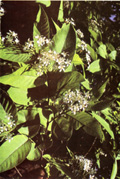| Latin Name | Holarrhena antidysenterica (Linn.) Wall. (Apocynaceae) |
| English Names | Connessi bark, Coneru, Tellicherry bark |
| Sanskrit Names | Kutaja, Vatsaka |
| Hindi Names | Kura, Kora, Kureya, Kurchi |
 History: The tree is believed to have sprung from the drops of ‘amrita’ (nectar) that fell on the ground from the bodies of Rama’s monkeys who were restored to life by Indra. The seeds and bark have been used in Materia Medica for a very long time. Arabic and Persian writers call the seeds Lisan-el-asafir-el-murr, and Zaban-i-gungishk-i-talk (bitter sparrow’s tongue) respectively. The Portuguese physicians, Garcia and Christopher a Costa use the names Coru, Curo, Cura and Corte de pala. Ainslie mentions the bark as having been lately admitted into British materia medica, under the name of Conessi bark. This bark enjoyed for a time considerable repute in Europe. Sir Walter Elliot, regarded it as one of the most valuable medicinal products of India. In 1887, M.R. Blondel discussed and illustrated the botanical history and structure of this plant. Distribution: Occurring almost throughout India up to an altitude of 4,000 ft.; it is especially abundant in the sub-Himalayan tract. Habit: H.a. is a deciduous shrub or small tree. The bark is rather rough, pale brownish or greyish; the leaves are opposite, subsessile, elliptic or ovate-oblong, membranous; the flowers are white, in terminal corymbose cymes; the follicles, divaricate, cylindric and usually white spotted ;the seeds are light brown. Principle constituents: The principal alkaloid of kurchi is conessine. The other alkaloids reported to be present in the bark are: conamine, conkurchine, connessimine, kurchine, conarrhinine, holarrhinene, isoconcessimine. Indications: The bark has astringent, antidysenteric, anthelmintic, stomachic, febrifugal and tonic properties. It is used in the treatment of amebic dysentery and diarrhea. Product range: Diarex |
|